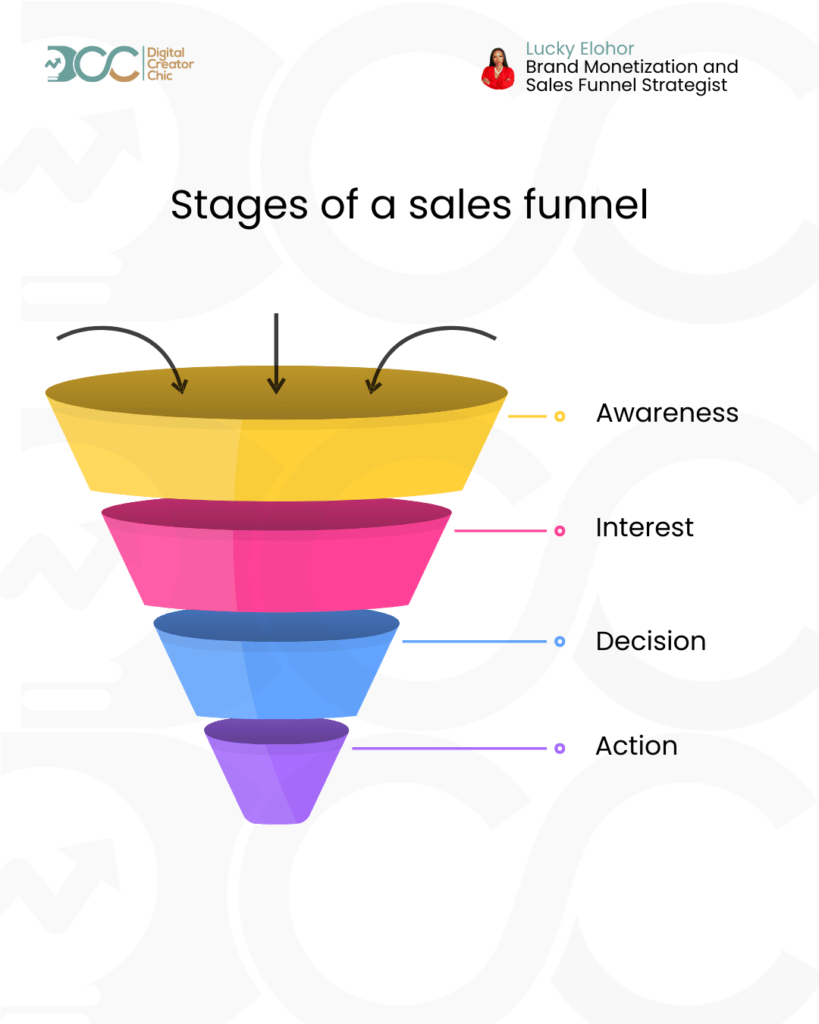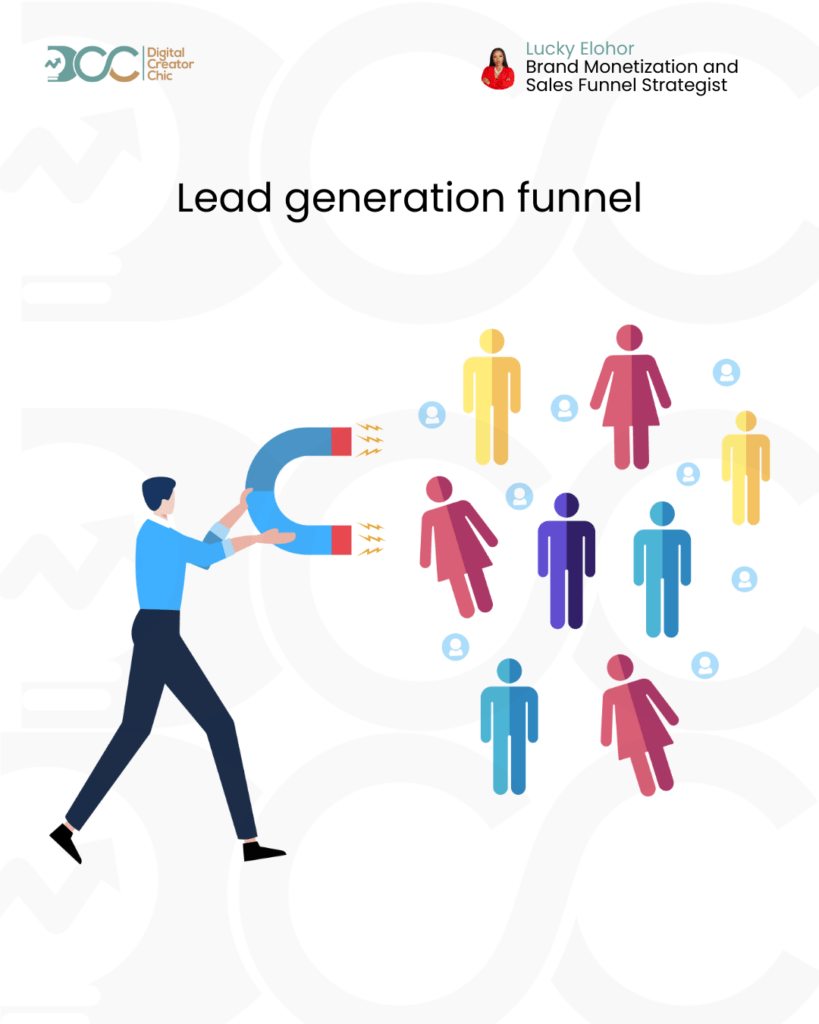In today’s fast-paced and highly competitive business environment, understanding and utilizing a sales funnel is no longer optional; it’s a necessity. Businesses that successfully implement sales funnels often see significant boosts in conversions, customer retention, and overall revenue. In this guide, we will dive into what a sales funnel is, the different types and methods of sales funnels, and how you can use them to skyrocket your conversions in 2025. If you’re new to this concept or looking to optimize your existing funnel, you’re in the right place.
What is a Sales Funnel?
A sales funnel is a step-by-step process that guides potential customers from being aware of your product or service to making a purchase and becoming loyal customers. Think of it as a journey that your audience takes, starting with discovering your business and ending with a transaction (and ideally, repeat purchases).
The term “funnel” is used because the number of people involved narrows as they move through the stages. At the top, you have a broad audience of potential customers. As they proceed through the funnel, only a fraction of them will convert into paying customers.
Stages of a Sales Funnel
Most sales funnels are broken down into four primary stages, often remembered by the acronym AIDA:
- Awareness: This is where potential customers learn about your business. It could be through social media ads, blog posts, word of mouth, or other marketing efforts.
- Interest: At this stage, prospects are curious and want to learn more about what you’re offering. They might explore your website, read reviews, or sign up for your email list.
- Decision: Prospects are evaluating their options and deciding whether your product or service is the best fit for their needs. This is where offers, discounts, and testimonials can tip the scale in your favor.
- Action: The final stage—this is where the prospect becomes a paying customer. This could involve completing a purchase, signing up for a service, or subscribing to your product.

Understanding these stages is crucial for designing a funnel that resonates with your audience.
Different Types of Sales Funnels
There’s no one-size-fits-all sales funnel. The type of funnel you create should align with your business model, audience, and goals. Here are some popular types of sales funnels:
1. Lead Generation Funnel
This funnel is designed to capture leads by offering something valuable in exchange for contact information, such as an email address. Examples include free eBooks, webinars, or cheat sheets. Once you’ve captured the lead, you nurture them with emails and content until they’re ready to buy.

2. Sales Funnel for E-commerce
E-commerce businesses often use sales funnels to guide customers through the buying process. These funnels may include product pages, upsells, and retargeting ads to reduce cart abandonment.
3. Webinar Funnel
If you’re selling high-ticket products or services, a webinar funnel can be highly effective. It typically involves driving traffic to a registration page, hosting a value-packed webinar, and ending with a pitch for your product or service.
4. Membership Funnel
For businesses offering subscription-based services or memberships, this funnel focuses on attracting and converting long-term members. Free trials and tiered pricing are common features in this type of funnel.
5. High-Ticket Funnel
If you’re selling premium services or products, you’ll need a more tailored approach. High-ticket funnels often include consultations, personalized offers, and one-on-one interactions to build trust and justify the investment.
This type of funnel leverages blogs, videos, and social media content to educate and engage your audience. The goal is to build trust and nurture leads until they’re ready to convert.
Examples of Businesses That Have Leveraged Sales Funnels to 10x Their Conversions
1: Lucky Elohor – Digital Creator Chic
Lucky Elohor used a high-converting sales funnel to promote her signature course “Course Launch Blueprint”. By offering a free training series and engaging email sequences, she built a relationship with her audience that led to higher conversion rates for her signature course and her other services.
- Key Insight: Elohor’s success came from personalizing her funnel to appeal to creators and service based business owners pain points, using a combination of content and high-value offers to push them toward making a purchase.
2: Russell Brunson – ClickFunnels
Russell Brunson, the founder of ClickFunnels, transformed his business using sales funnels. He went from zero to over $100 million in annual revenue in a few years by leveraging his own funnel-building software, ClickFunnels. By using value-driven lead magnets like free books and webinars, he was able to generate leads and nurture them through a series of upsells and automation.
- Key Insight: By continually optimizing his funnels for maximum conversions and testing different strategies, Russell was able to scale rapidly without increasing his manual workload.
3: Amy Porterfield – Online Courses
Amy Porterfield’s use of sales funnels helped her scale her business to over $10 million in annual revenue. She used webinars as a central component of her sales funnel, with free webinars attracting new leads and ending with a pitch for her premium courses.
- Key Insight: Amy’s strategy of building trust through educational content and using automated email sequences helped convert interested leads into high-paying customers.
4: Jeff Walker – Product Launch Formula
Jeff Walker is known for his “Product Launch Formula,” which has helped thousands of entrepreneurs build successful sales funnels. His own business grew significantly by using a pre-launch content sequence that educated and engaged his audience before opening sales.
- Key Insight: Jeff’s approach to building anticipation and creating scarcity in his launch funnels maximized conversions and generated massive sales during each product launch.
Methods for Building Effective Sales Funnels
Creating a successful sales funnel involves more than just setting up a website or sending emails. Here are proven methods to ensure your funnel delivers results:
1. Understand Your Audience
The foundation of any effective sales funnel is a deep understanding of your target audience. What are their pain points, desires, and objections? Conduct surveys, analyze data, and create detailed buyer personas to ensure your funnel speaks directly to their needs.
2. Offer a Lead Magnet
A lead magnet is something valuable you offer for free to capture leads. Examples include guides, templates, or discount codes. Your lead magnet should solve a specific problem for your audience and encourage them to take the next step.
3. Create Compelling Landing Pages
Your landing page is often the first touchpoint in your funnel. Make it visually appealing, include a clear call-to-action (CTA), and focus on the benefits of your offer. Avoid clutter and distractions.
4. Use Email Marketing to Nurture Leads
Email sequences are a powerful way to keep your leads engaged. Share valuable content, address common objections, and guide them toward making a purchase. Tools like Mailchimp or ActiveCampaign can help automate this process.
5. Leverage Upsells and Downsells
A sales funnel isn’t just about leading someone to a single purchase. Once a customer makes a purchase, offer them a complementary product (upsell) or a lower-priced alternative (downsell). This can significantly increase your average order value.
6. Utilize Social Media
Social media is a powerful tool for building and maintaining your sales funnel. Platforms like Instagram, TikTok, and Facebook allow you to engage with your audience, drive traffic to your funnel, and even close sales directly. Paid ads, influencer collaborations, and live video sessions are great ways to boost your funnel’s performance.
7. Retarget Abandoned Carts
If you run an e-commerce business, use retargeting ads and follow-up emails to recover lost sales from customers who abandon their carts. Incentives like discounts can be highly effective here.
8. Analyze and Optimize Your Funnel
No sales funnel is perfect from the start. Use analytics tools to monitor performance, identify bottlenecks, and make adjustments. Test different CTAs, headlines, and email sequences to see what resonates most with your audience.
How Any Business Can Leverage a Sales Funnel to 10x Their Conversions in 2025
In 2025, sales funnels will continue to be a cornerstone of business success, and leveraging them effectively can significantly amplify your results. Here’s how any business can use a sales funnel to 10x their conversions:
1. Embrace Personalization
Customers expect tailored experiences. Use data and AI tools to create personalized funnels based on user behavior. For example, recommend products based on past purchases or browsing history.
2. Focus on Video Content
Video remains one of the most engaging content formats. Use video ads, explainer videos, and testimonials to build trust and drive conversions.
3. Optimize for Mobile
With more people shopping and browsing on their phones, ensure your funnel is mobile-friendly. Fast-loading pages and easy navigation are critical.
4. Leverage Social Proof
Customer reviews, testimonials, and case studies are powerful tools for building trust. Highlight these throughout your funnel to reassure potential buyers.
5. Implement AI-Powered Chatbots
Chatbots can answer questions, recommend products, and guide users through the buying process in real time. This can reduce friction and increase conversions.
6. Utilize Multi-Channel Marketing
Don’t rely on just one platform. Use a mix of social media, email marketing, SEO, and paid ads to reach your audience at every touchpoint. Multi-channel strategies ensure your audience engages with your brand wherever they are.
7. Partner with a Sales Funnel Strategist
Building an effective funnel is not just about technical setup; it requires strategy and execution. This is where working with a sales funnel strategist like me can make all the difference.
Why You Need a Sales Funnel Strategist
Building and optimizing a sales funnel can be overwhelming, especially if you’re managing other aspects of your business. As a sales funnel strategist, I specialize in helping businesses create custom funnels that convert. Here’s how I can help:
- Tailored Funnel Design: I’ll work with you to design a funnel that aligns with your unique goals and audience.
- Data-Driven Optimization: Using analytics, I’ll identify and fix weak points in your funnel to maximize conversions.
- Comprehensive Support: From lead magnets to email sequences, I’ll handle all the moving parts to ensure your funnel runs smoothly.
If you’re ready to take your business to the next level, let’s work together. Contact me today for a free consultation!
Conclusion
A well-designed sales funnel is one of the most effective tools for growing your business. By understanding your audience, offering value at every stage, and optimizing your funnel for 2025 trends, you can significantly boost your conversions. Whether you’re starting from scratch or looking to improve an existing funnel, investing in this strategy will pay dividends for years to come.
A sales funnel goes beyond having a landing page or sending emails—it’s a dynamic process that includes upselling, leveraging social media, and creating engaging content. Don’t leave your business growth to chance. Leverage the power of sales funnels and watch your conversions soar. Need help getting started? Reach out, and let’s create a sales funnel that works for you.



